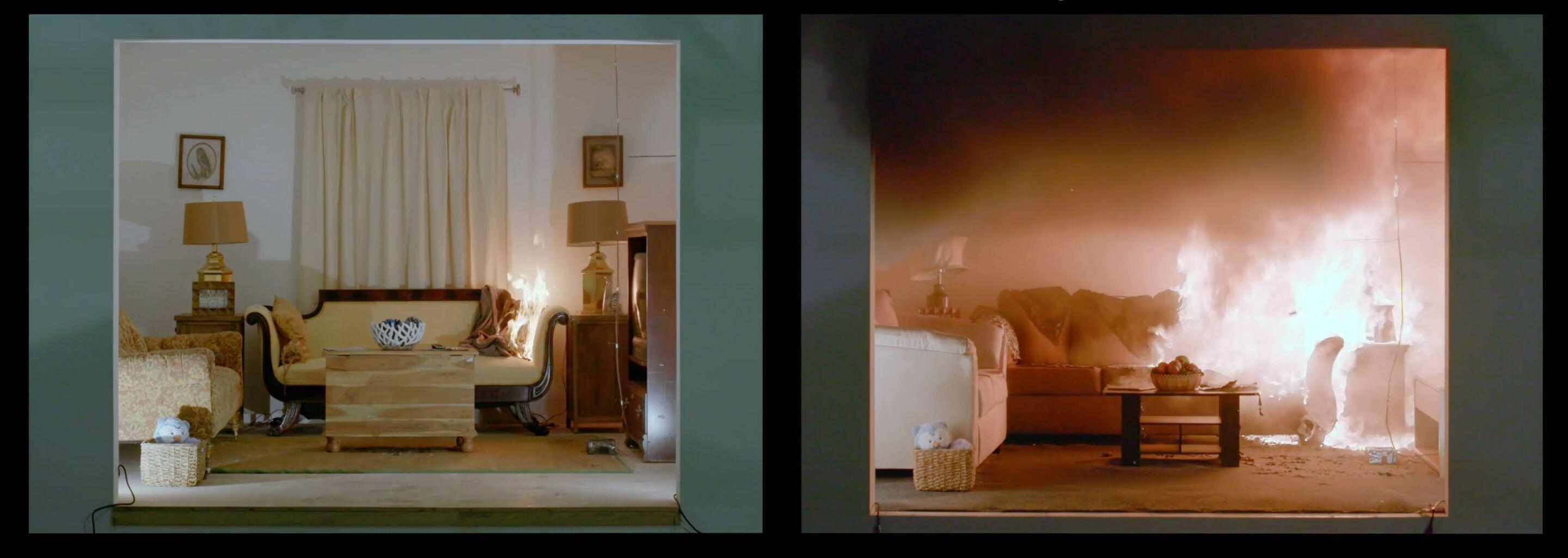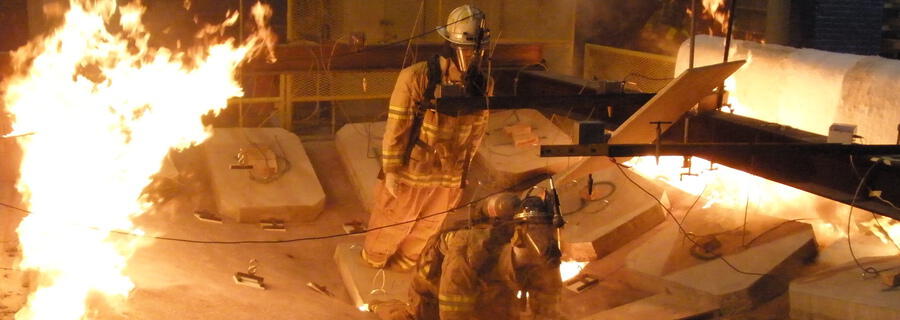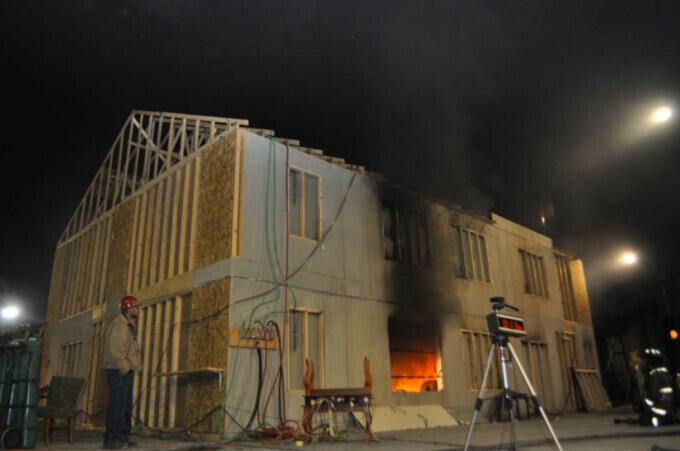NEW Comparison of Natural and Synthetic Home Furnishings Video Now Available!
In 2020, the UL FSRI team captured a new side-by-side burn comparison of natural vs. synthetic furnished rooms. Since the original comparison video was shared in 2009, UL FSRI has repeated the same experiment several times with similar results in terms of flashover times between the natural and synthetic furnished rooms. The flashover data from those experiments has been incorporated into this new video that has been captured in much crisper detail than its predecessor thanks to vast video technology enhancements.
Click here to download the new comparison video to integrate into your department training.
About The Experiments:
Two identically sized living rooms were constructed, each measuring 12 ft by 12 ft with eight foot ceilings and an eight foot wide by seven foot tall opening on the front wall. Both rooms contained similar amounts of like furnishings, with the variable being that one living room was outfitted with furnishings made from natural materials, such as cotton and wood, and the other was outfitted with furnishings constructed of synthetic materials such as polyester and polyurethane foam.
The synthetic room transitioned to flashover in 4 minutes and 50 seconds and the natural room took more than 30 minutes.
Both rooms were ignited by a small open flame replicating common causes of furnishing ignition sources such as lit smoking materials or a small battery powered device that was being charged inappropriately.
Synthetic room contents:
The room containing synthetic materials was lined with a layer of 1/2 inch painted gypsum board and the floor was covered with polyolefin carpet and rebound polyurethane padding. The furnishings included a polyester fabric covered polyurethane foam filled sofa and loveseat, engineered wood coffee table, end table and television stand. The sofa had a polyester throw placed on its right side. The end tables each had a ceramic and metal lamp with a linen shade on top of a wire frame. The left end table also held a picture frame made of vinyl laminate over a medium density fiberboard (MDF) frame with glass and cardboard. The right end table also held a glass vase. The television stand held a 35.5-inch flat screen TV. The coffee table held a plastic basket filled with plastic fruit and a plastic TV remote control. To the left of the loveseat sat a wicker basket at floor level made of woven seagrass with two polyester stuffed animals filled with polyester fill and beads. The rear wall had polyester curtains hanging from a metal rod and canvas wall art over a wooden frame.
Natural room contents:
The room containing natural materials was lined with 1/2 inch painted cement board and the floor was covered with hardwood flooring. The furnishings included a cotton covered, cotton padding sofa with a wood frame, a cotton covered, blended material filled loveseat, solid wood coffee table and two end tables, and a wooden TV cabinet. The large cotton sofa had a cotton blanket placed on its right side. Both end tables had a lamp with a linen fabric over a wire frame shade. A wicker basket was located on the floor in front of the right side of the sofa at floor level. The coffee table had two magazines, a plastic TV remote and a ceramic bowl filled with pinecones. The TV cabinet held a CRT glass tube TV with a plastic casing. The rear wall had cotton curtains hanging from a metal rod and two pieces of wall art made of cardboard, glass and wooden frames.
When a fire burns in a house, it consumes oxygen and generates toxic products of combustion (smoke). Oxygen levels decrease as the toxic smoke spreads through the house. Smoke may incapacitate a building occupant near or remote from the fire room before flashover occurs. Flashover is the transition phase in the development of a room fire in which fuel surfaces, exposed to thermal radiation from fire gases in excess of 600 degrees C (approximately 1100 degrees F), reach ignition almost simultaneously and fire spreads rapidly through the space.
UL FSRI conducted these experiments several times utilizing similar furnishings. This table shows the respective consistency of time to flashover between the natural and synthetic furnished rooms.
Natural vs. Synthetic Times to Flashover (min:sec)
| Experiment | Room with Natural Furnishings | Room with Synthetic Furnishings |
|---|---|---|
| 1 | 29:30 | 3:40 |
| 2 | > 30 | 4:45 |
| 3 | > 30 | 3:20 |
| 4 | > 30 | 4:50 |
NEW Public Safety Announcement Video:
UL FSRI has also been able to utilize this new footage of the synthetic room burning to create a public safety announcement that aims to drive awareness of how little time there is to escape a home fire and urges people to plan ahead by having working smoke alarms, knowing their escape plan, and close bedroom doors at night before bed.
Click here to download this Public Safety Announcement video to share it with your community.
The original inspiration:
In 2009, UL conducted an experiment to evaluate the impact that different household furnishing materials have on time to flashover in a residential fire. For years, the video capturing this experiment provided a tangible, visual proof point of how synthetic furnishings burn faster than natural. Similar to the new video, the original involved two identically sized living rooms were constructed and contained similar furnishings with the variable of one containing natural materials while the other contained mainly synthetic materials.
Click here to download the original report.
Since the release of the original video, it has been a tangible example and foundation for discussion on the dangers of today’s fire environment not only for firefighters, but also for the public. Knowing the importance of sharing this research and dramatic visual, UL FSRI decided to reconstruct the experiment and release a higher definition video to help spread the word.
If currently utilizing the 2009 version, consider replacing it with the newer version at the top of this post.
Interested in more information?
Click here to sign-up for the UL FSRI Newsletter and recieve future updates on this project.



